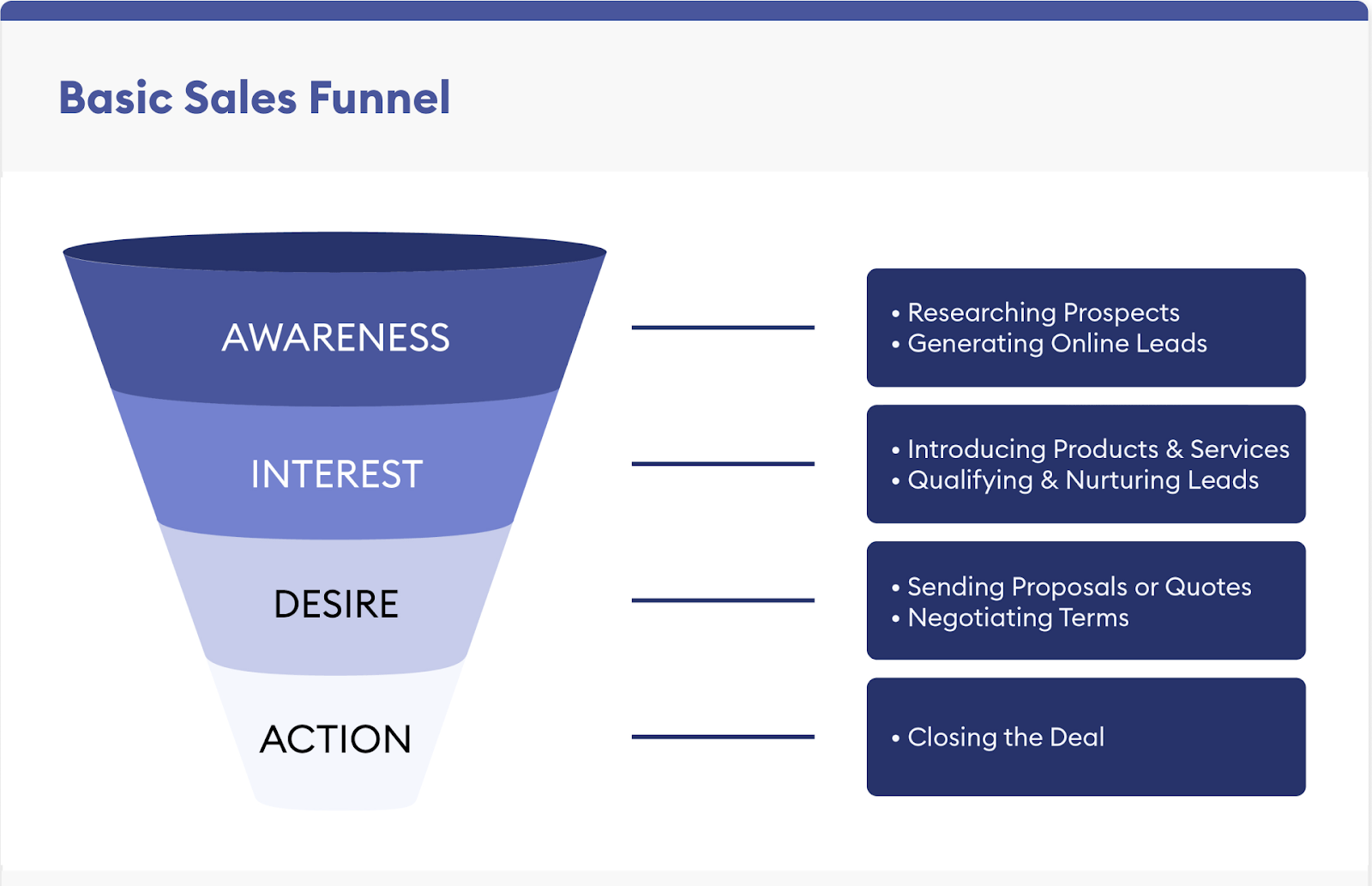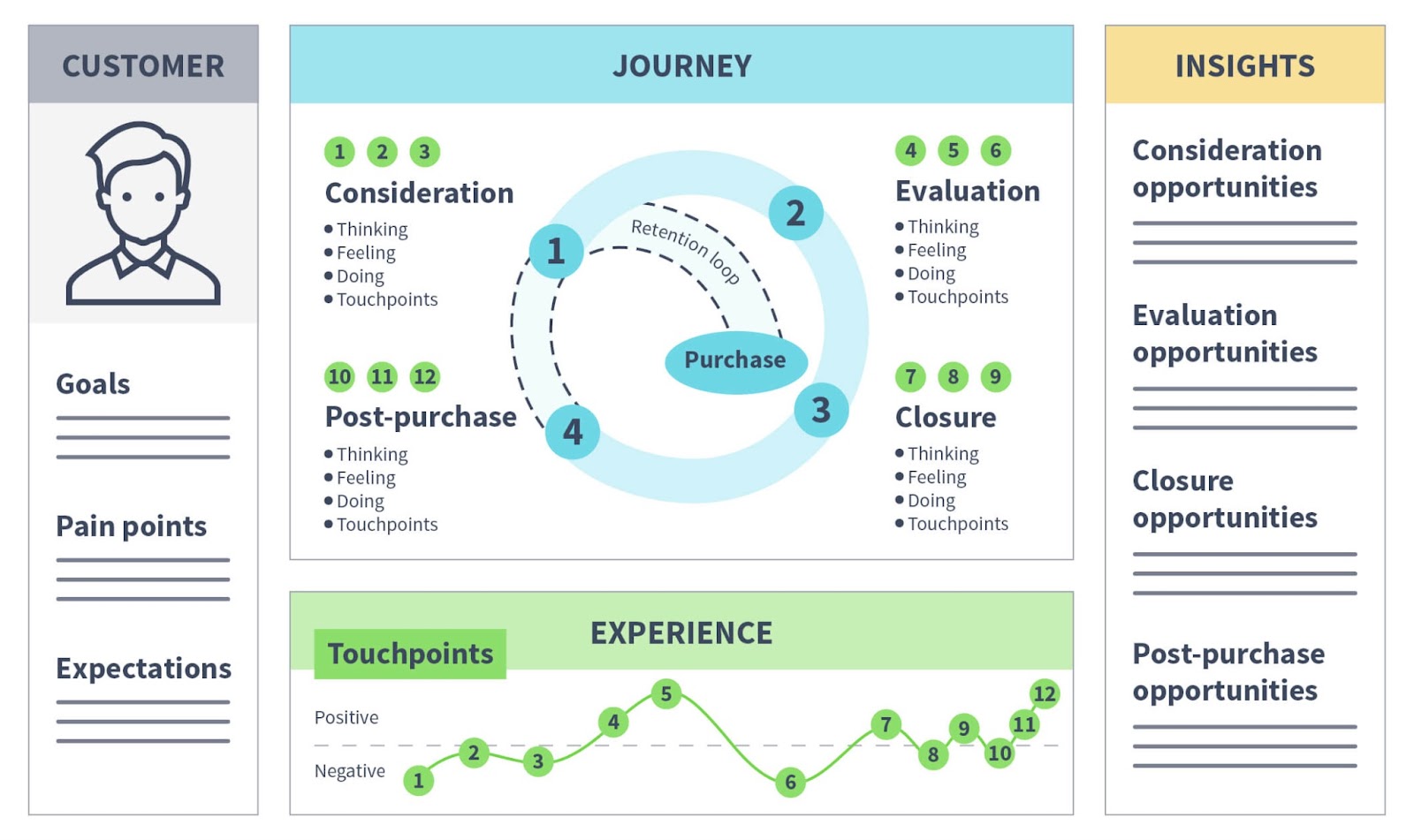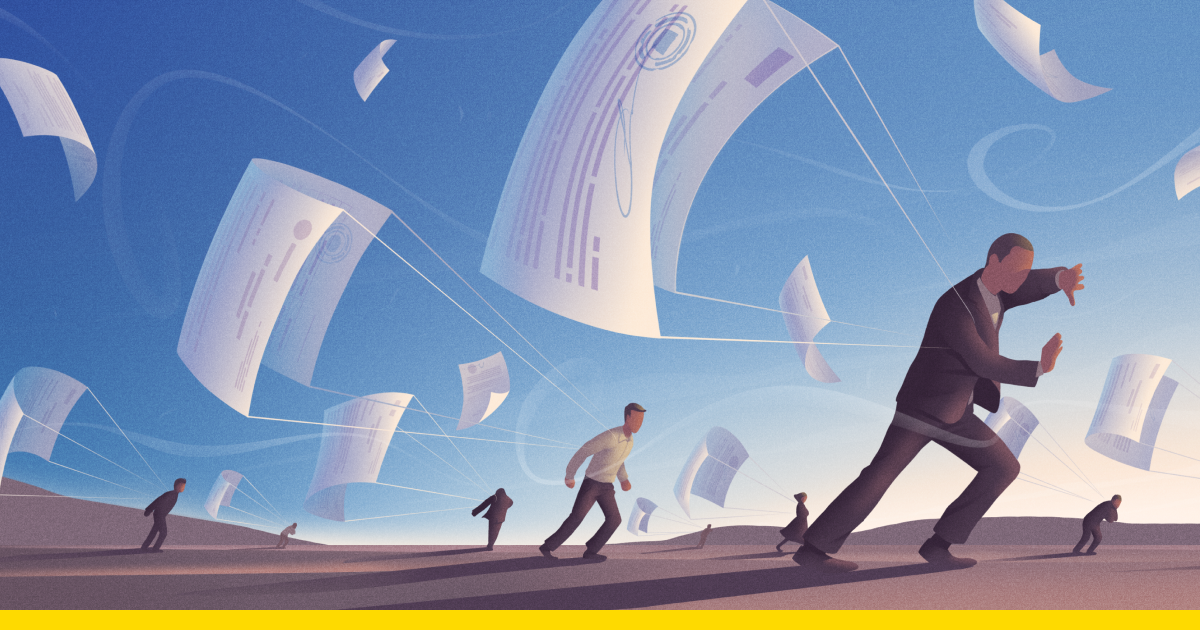Article written by Alina Vasylenko, Business Analysis and Sales Management expert
The art of selling isn’t just about making a pitch; it’s about guiding prospects through a carefully orchestrated journey.
The sales funnel, often termed the “customer journey,” is an essential tool in understanding how potential customers become committed clients. More than just a concept, it offers a strategic way of thinking about the customer’s path from first impression to the acquisition decision. This journey might be imagined as traveling through a funnel, which is broad at the top and hones in on, symbolizing filtering out those who aren’t a fit for the offer and retaining those who are close to sealing the deal.

Let’s break it down:
At the initial recognition stage, an IT company specializing in custom software development can sponsor a tech conference, run online ads, or publish insightful articles about the latest trends in software development, for instance, share blogs about the advantages of cloud computing. This broad approach is aimed at drawing attention from an extensive pool of prospects.
During the subsequent interest stage, the company might offer free webinars about the merits of custom software, or how businesses can enhance their operations through tailored IT solutions. They’re trying to engage those who showed initial interest. For instance, Microsoft might host webinars about the advantages of using Microsoft Azure for business needs.
At the point of the consideration stage, the IT firm might offer prospective clients a free consultation or an analysis of their existing systems. They want to showcase their expertise and provide value. For example, an IT security company might offer a free vulnerability assessment to potential clients.
At the decision stage, detailed proposals are presented, perhaps offering a prototype or a demo of what the final product might look like. Adobe, for instance, offers a trial version of its Creative Cloud suite, allowing users to try before they buy.
At the action stage, the actual deal is sealed. The client signs the contract, and the project kicks off. For instance, when a business decides to adopt Salesforce as its CRM solution, this stage involves purchasing the right package, setting it up, and integrating it into the business processes.
Lastly, at the retention, or post-purchase, stage, the IT company continues to engage, offering support, updates, and perhaps upsell or cross-sell opportunities. Apple, for example, doesn’t just sell you an iPhone. They continue to publish software updates, app recommendations, and even accessories or device promotions.
The complexity of the sales funnel within the IT niche stems from the intricate nature of its offers. Enterprise-grade features and hardware can be way too convoluted, demanding considerable commitment and understanding from prospective clients. Utilizing the sales funnel offers a systematic method to navigate them through their decision-making process, guaranteeing tailored insights and assistance at each juncture.
Mapping the conversion journey in IT development
Grasping the distinct stages of the industry-specific sales pathway empowers IT development firms to craft a fluid journey for their prospects. Every phase, from the discovery to fostering long-term loyalty, holds paramount significance. Let’s delve into these essential phases.
Discovery phase
The initial interaction sets the tone, and the exploration groundwork is the juncture where IT firms leave a memorable mark. During this period, prospective clients get their first glimpse into what you offer. Crucial undertakings encompass:
- Content strategy: Disseminating insightful, pertinent, and solution-centric content that touches upon industry challenges and market dynamics while emphasizing your capabilities. This can manifest as articles, visual data representations, and video segments, among others.
- Virtual workshops: Organizing digital seminars or instructional sessions can elevate your brand as a pioneering authority in the sector. These gatherings serve as a conduit to impart knowledge, highlight your solutions, and facilitate direct discourse with intrigued parties.
- Digital presence: Ensuring a strong online presence through an intuitive site, active social media instruments, and engaging multimedia content can captivate and draw in visitors.
- Online visibility: Adopting strategies for Search Engine Optimization (SEO) ensures that your enterprise prominently features on search engine listings, simplifying the journey for prospects to stumble upon your offerings.
Engagement phase
After making a prospective client cognizant of your offers, the subsequent move is nurturing that budding curiosity and deepening the bond. Essential actions in this phase are:
- Customized email outreach: Dispatching bespoke email correspondences that resonate with the distinct desires or preferences of the potential client can exemplify your dedication and insight into their specific challenges.
- Specialized content: Offering advanced resources, such as whitepapers or e-books, provides deeper insights and further establishes your expertise.
- Direct communication: Partaking in direct conversations, be it via telephonic conversations, video interactions, or face-to-face sessions, fosters confidence and paves the way for a comprehensive understanding of the client’s requirements.
Evaluation phase
This is, no more no less, an inflection point as potential clients weigh their options and mull over the feasibility and merits of partnering with you. Key components include:
- Detailed proposals: Crafting comprehensive proposals that outline the scope, timelines, costs, and expected aftermath can provide clarity and set realistic expectations.
- Real-world applications: Sharing practical demonstrations and sample cases of past projects validates your aptitude and gives those considering your services a glimpse of measurable accomplishments.
- Demo showcases: Offering live demonstrations or trial versions grants clients an on-the-spot understanding of operational advantages and value.
- Expert consultations: Arranging clients’ consultations with subject matter experts responds to tech-specific questions and showcases the synergy between your solutions and their aspirations.
Implementation phase
The lead has been converted, and it’s now the right moment to officially seal the partnership and kickstart the collaboration. Principal activities encompass:
- Client onboarding: This lays out a clear roadmap to bridge clients with the firm’s in-house team members, set communication protocols, and establish project milestones.
- Formalizing agreements: Drawing up and signing contractual agreements that outline responsibilities, deliverables, terms, and conditions.
- Inaugurating the project: This could be by means of a kickoff meeting, stipulating timelines, allotting assets, and outlining the project’s blueprint.
Loyalty (post-engagement) phase
Even after the sale or project completion, engagement should continue to ensure client satisfaction and explore future collaboration opportunities. Key elements include:
- Unwavering support: Offering consistent post-sale technical and customer support ensures that clients continue to derive value from the solution and address any issues they might encounter.
- Regular updates: Keeping clients informed about any feature enhancements or updates signals the firm’s unceasing drive for consistent betterment.
- Capturing client responses: Diligently soliciting feedback identifies areas for betterment and potential fresh capabilities or solutions that clients might seek.
- Opportunities for added offers: Proactively identifying and presenting additional opportunities and enhancements fosters continuous collaboration and reinforces the partnership.
When should one adopt a customized flow?
The above blueprint illustrates the typical progression a prospect undergoes, from initial awareness to the final purchase decision. However, this blueprint isn’t an unchangeable doctrine. Here’s why:
- Product/service specifics: The funnel’s relevance varies based on what’s on the table. A luxury enterprise solution may necessitate an extensive engagement approach, contrasting starkly with an affordable consumer item.
- Strategic focus: Companies might weigh some stages heavier, aligning with their overarching game plan. A brand-emphasizing content might leapfrog from initial interest straight to conversion, bypassing the contemplation phase.
- Consumer dynamics: Different market segments traverse the funnel differently. While corporate clients may linger in the assessment phase, casual consumers could seamlessly glide from recognition to acquisition.
- Sales intricacy: High-end offerings might compel prospects to meander through multiple educational and evaluative steps, whereas straightforward items might beckon a more linear journey.
- Online vs. face-to-face sales: E-commerce, given its nature, might present a more abbreviated funnel compared to brick-and-mortar transactions, which could involve deeper interpersonal interactions.
- Fluid funnel designs: Companies, driven by analytics and feedback, might tweak their funnels. Inefficient or irrelevant stages could be redefined or omitted.
To encapsulate, while the sales funnel serves as a helpful guideline, it’s not an immutable rulebook. Its malleability allows businesses to sculpt it according to their specific context, target demographic, and aspirations.
Challenges confronting IT development firms in the sales flow
The domain of development isn’t just about creating avant-garde solutions; it’s also about ensuring these innovations reach the pertinent segment and align with their demands. However, while maneuvering through this flow, IT development companies often encounter several distinct hurdles.
The battle to distinguish in a saturated marketplace
With the digital world booming, numerous IT development firms are sprouting up every day. This abundance presents a conundrum: How can one company distinguish itself from countless others? Establishing a unique selling proposition, maintaining a stellar service record, and consistently innovating is essential. But it’s equally crucial to convincingly communicate these strengths at every tier in the process, from the onset of interaction to the closing deal.
Bridging the technical understanding chasm
Not every prospect is well-acquainted with convoluted tech nuances. There’s often a pronounced gap between what IT development companies deliver and the clientele’s grasp of those offers. Overcoming this entails not merely educating the other party but additionally framing complex solutions in a fashion that underscores their tangible benefits.
Client education: The goal isn’t to flood the other party with every technical nuance but to impart knowledge in a digestible way. Workshops, webinars, or simplified documentation are instrumental. By breaking down complex terms into easily understandable concepts and showcasing tangible scenarios or analogies, organizations aid clients in better grasping the essence of their deliverables.
Benefit-centric communication: Instead of leading with features, lead with benefits. Focus on how it can streamline operations, reduce costs, or enhance user experience. Clients resonate more with tangible outcomes, so framing the conversation around how the technology directly benefits their business can be a game-changer.
Tips and the gold standard for the IT niche
To traverse the sales spectrum in IT development, it’s imperative to see beyond just service excellence. Constructing an impactful sales framework means immersing oneself in the industry’s depth and connecting with potential clients’ needs. Below, we share a set of established approaches and best practices, honed especially for IT development agencies:
Personalize each journey
Each prospect brings their own set of requirements, challenges, and goals to the table. Eschew the generic strategy. Opt for a customized engagement and presentation that aligns with the nuances of every client. Showcasing a keen insight into their bespoke needs not only builds credibility but also enhances the likelihood of cementing a fruitful relationship.

To illustrate, at Andersen, specialists offer three cooperation models to pick from, i.e. dedicated teams, a fixed-priced approach, and PDS. What’s more, the company provides an expansive range of services, from development based on the latest tech stacks to DevOps and IT architecture. Thus, anyone can find exactly what they need when they address this developer.
Prioritize transparent communication
Especially during the pivotal choice-making point, clarity is paramount. Clear communication regarding deliverables, likely hurdles, timelines, and costs resonates with the other party. By addressing issues head-on and being candid, you can mitigate potential worries while cultivating a trusting relationship, enhancing the chances of forming a fruitful collaboration.
Champion a feedback-driven approach
The sale’s conclusion doesn’t mean the finale of the collaboration. Progressive IT development firms understand the weight of post-sale interactions. Regularly solicit feedback, both positive and constructive. This underscores your allegiance to perpetual advancement, encouraging client loyalty and potential future collaborations.
To sum up
A streamlined and systematic sales funnel is, in fact, a structured guide that ensures that prospects are not only introduced to a company’s offers but are also smoothly transitioned from mere awareness to loyal patronage.
The dynamism of the sector implies that what works today might need recalibration tomorrow. Therefore, it is imperative for companies to remain agile, consistently evaluating and finetuning their sales funnels. By staying attuned to market shifts, emerging technologies, and invaluable client feedback, businesses can ensure that their sales processes remain robust, relevant, and resonant.






















